Snapdragon 800 (MSM8974) Performance Preview: Qualcomm Mobile Development Tablet Tested
by Brian Klug on June 18, 2013 8:00 PM ESTCPU Performance
The state of CPU performance testing under Android is unfortunately still quite broken. We're using a mix of browser based tests with Java & Native apps (AndEBench).
The key comparisons to look for are the Snapdragon 800 MDP/T vs. the Exynos 5 Octa (4 x ARM Cortex A15s) based Galaxy S 4 (SHVE300S), the Exynos 5 Dual (2 x ARM Cortex A15s) based Nexus 10 tablet and any of the Snapdragon 600 based smartphones (HTC One/T-Mobile Galaxy S 4) running two Krait 300s at 1.7/1.9GHz.
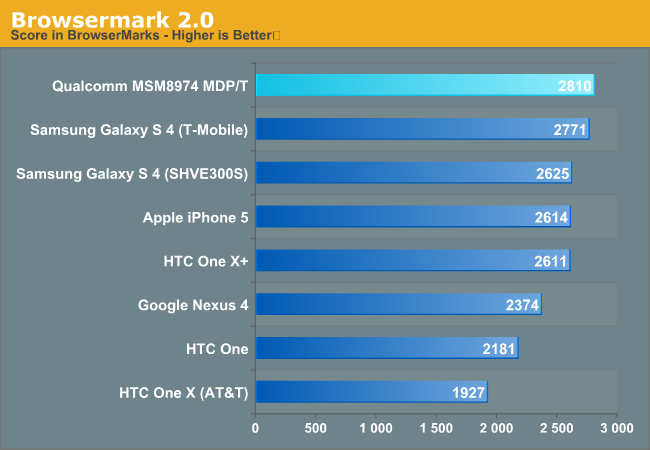
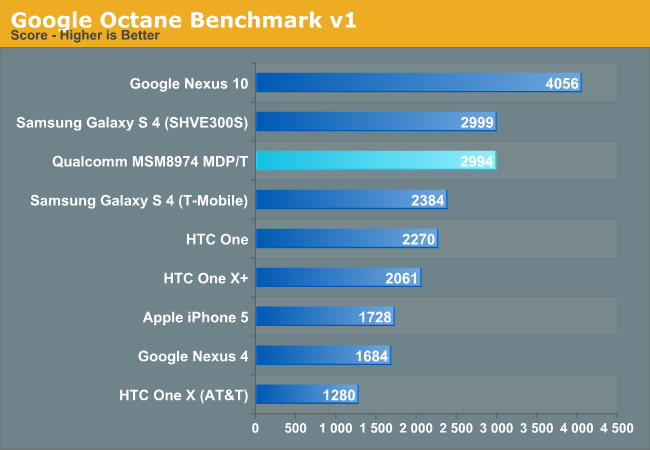
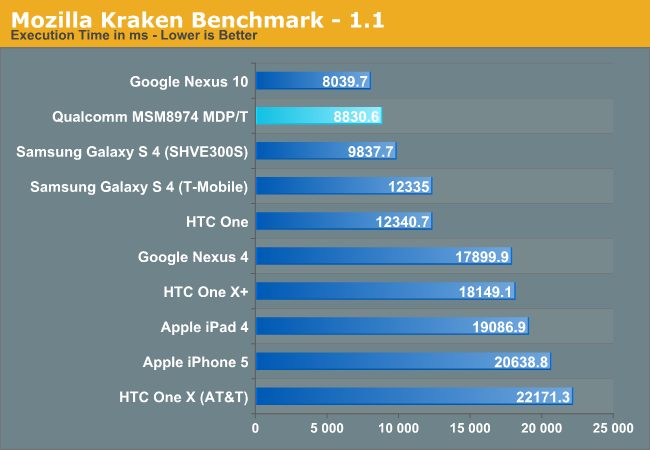

Krait 400 seems to do very well against ARM's Cortex A15, trading positions in terms of performance depending on the test. As these are browser based benchmarks there's a big software component to variability that prevents big conclusions from being made here, but it's clear that Snapdragon 800 is in a similar performance class to current Cortex A15 based designs.
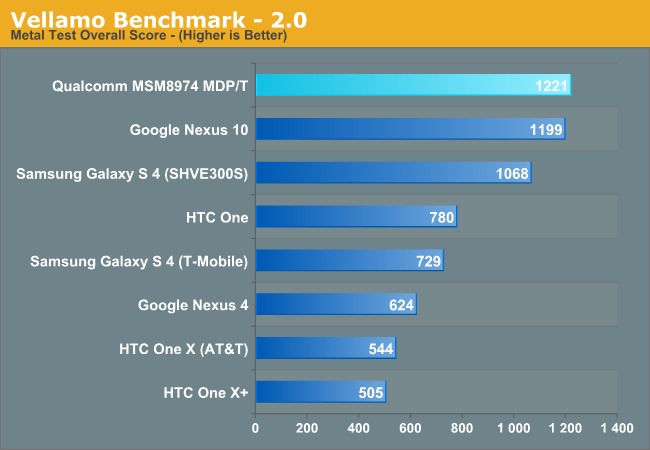
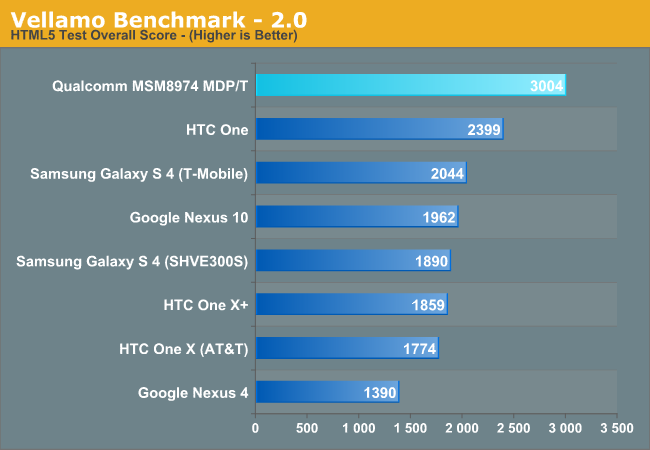
AndEBench
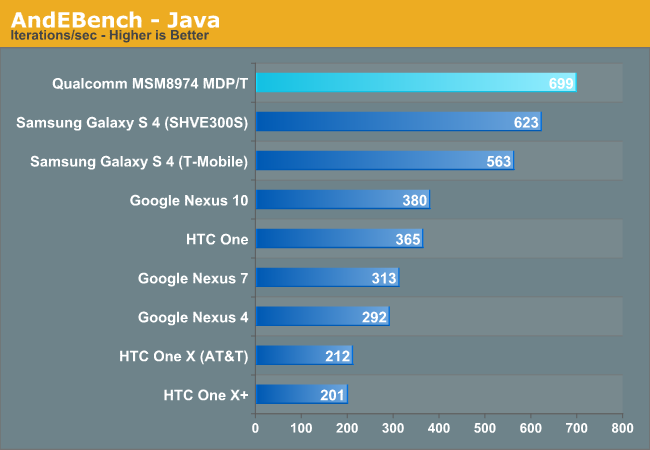
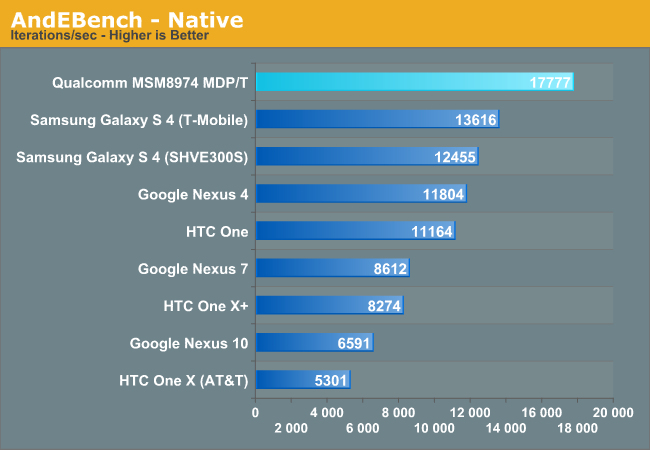
The Java and Native client AndEBench tests echo what we've seen elsewhere: Snapdragon 800 can definitely be quicker than ARM's Cortex A15, and at least is in a similar class.










115 Comments
View All Comments
Bob Todd - Wednesday, June 19, 2013 - link
That would be awesome, but I highly doubt it. Unless they radically change their target market for that device, I don't think you'll see a bleeding edge SOC or super high resolution display. It was meant to win back the market share lost to the likes of the budget friendly Kindle/Nook tablets who were eating Google's lunch in the tablet market while using their OS at the core. I just don't see a Snapdragon 800 in a ~$200 device, for the same reasons you don't see Swift or Retina displays in the iPad Mini. I think we're much more likely to see an S4 Pro quad/Adreno 320 (possibly Snapdragon 600?). Even that would be a hell of an upgrade to the existing Tegra 3, and I'd happily throw my Nexus 7 up on eBay for that. Admittedly, I may end up with an x86 Windows 8.1 tablet with Silvermont or Temesh instead of the next Nexus 7 anyway.Krysto - Wednesday, June 19, 2013 - link
"Snapdragon 800 can definitely be quicker than ARM's Cortex A15"What does that sentence even mean? You're comparing 2.3 Ghz Krait 400 vs 1.7 Ghz Cortex A15.
aryonoco - Wednesday, June 19, 2013 - link
He's comparing what he has (Snapdragon development tablet) with other things that he has.Clock frequency is pointless to compare by itself. Sure A15 might be faster clock-for-clock, but it's also more power hungry so you won't be seeing it hit 2.0 Ghz anytime soon. Looks like a Snapdragon 800 can easily clock higher which more than compensates its IPC disadvantage compared to A15 while keeping power usage in check.
Qualcomm is sitting very comfortable right now. No wonder their market cap is now bigger than Intel, while they have a fraction of Intel's revenue/profits. The market clearly likes what they see from them.
Wilco1 - Wednesday, June 19, 2013 - link
A15 is already at 1.9GHz with Tegra 4. If A15 was built on 28nm HPM then it would also reach 2.3-2.5GHz. I bet we'll get something like that this year.Note there is no evidence A15 uses more power. In S4 tests it seems the Exynos Octa has lower power consumption than Krait.
Wilco1 - Wednesday, June 19, 2013 - link
Just came across this: http://arstechnica.com/gadgets/2013/06/qualcomms-s...Looks like Tegra 4 still beats it at 1.9GHz. And good to see some tech sites showing native benchmarks.
xinthius - Wednesday, June 19, 2013 - link
That isn't the impression I got from the article. CPU wise Tegra 4 edges it, but on the off-screen GPU tests Adreno has a solid lead.Wilco1 - Wednesday, June 19, 2013 - link
Tegra 4 finally has a fast GPU - nobody has benchmarked it yet but the one available score (Egypt HD at 57fps) suggests it will be a close match with Adreno.sherlockwing - Wednesday, June 19, 2013 - link
Tegra 4 is already A15 on HPM and it is capped at 1.9Ghz, no evidence on how much further it can be pushed. Also Exynos Octa have 4 A7s to reduce power consumption, in GSMArena's benches it still fall behind S600 in battery life.Wilco1 - Wednesday, June 19, 2013 - link
Anand says it is LPM (unlike Tegra 4i, which is HPM): http://www.anandtech.com/show/6550/more-details-on...The Exynos variant of S4 does indeed fall behind in battery life in the GSMArena test, but that was on talk time and video playback, ie. not related at all to the CPU. QC has a big lead in low-power modems and it shows. Browsing was within 6%, so that confirms that the A15 uses similar power as Krait to get slightly better performance. I'm still hoping Anand will do a full review...
aryonoco - Wednesday, June 19, 2013 - link
Yes, the architecture comparison between A15 and Krait 400 and next-gen Swift will be very interesting.Add in Bay Trail and Temash and we CPU enthusiasts are really experiencing a golden age. When was the last time we had so many different competing designs and architectures? When you compare the progress from Scorpion to Krait 200 to Krait 400 (or A9 to A15) in a matter of 2 years... the pace of development in the mobile world is astonishing.
I'm also relying on Anand to do some full analysis and review of all these architectures once they become available. It's pretty clear that Tegra 4 is going to be cheaper than Snapdragon 800, it would be great to see them side by side, with power analysis and all.